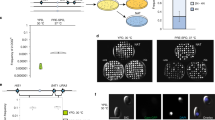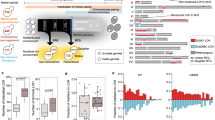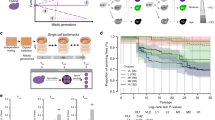Abstract
THE genes determining mating type in the fission yeast Schizosaccharomyces pombe are of particular interest in the general study of the genetic control of differentiation. The genetic segments concerned, mat1M and mat2P, specifying mating type (−) and (+), respectively1, are present, closely linked, in homothallic strains2, but on any one chromatid (that is in the cis position) they are only expressed in a mutually exclusive manner3. The segments of the mating-type locus, mat1M and mat2P, govern the transition from vegetative growth to sexual reproduction. They act in a complementary fashion—one functional M segment and one functional P segment are always required to initiate both conjugation (usually among haploid cells) and meiosis (leading to sporulation in either zygotes or diploid cells), the prominent events in differentiation in S. pombe. A mating-type mutant defective in meiosis but not in conjugation (mat1M mat2Pm) when crossed with wild type, produces sporulating and non-sporulating zygotes (Fig. 1). These two classes indicate that in individual cells of either parent strain only one or the other mating-type segment is active3. Here I describe a single-cell evaluation of this cross, and show (also by single-cell techniques) that the frequency of mating-type switching in haploid and diploid strains is approximately random. A favoured mechanism for this type of switching is the inversion of a promoter element between the structural genes, the direction of the promoter determining which mating-type segment is switched on.
This is a preview of subscription content, access via your institution
Access options
Subscribe to this journal
Receive 51 print issues and online access
$199.00 per year
only $3.90 per issue
Buy this article
- Purchase on Springer Link
- Instant access to full article PDF
Prices may be subject to local taxes which are calculated during checkout
Similar content being viewed by others
References
Egel, R. Molec. gen. Genet. 148, 149 (1976).
Leupold, U. Cold Spring Harb. Symp. Quant. Biol. 23, 161 (1958).
Egel, R. Molec. gen. Genet. 145, 281 (1976).
Egel, R. Molec. gen. Genet. 121, 277 (1973).
Hicks, J. B. & Herskowitz, I. Genetics 83, 245 (1976).
Nurse, P., Thuriaux, P. & Nasmyth, K. Molec. gen. Genet. 146, 167 (1976).
Egel, R. in DNA Insertion Elements, Plasmids and Episomes (eds Bukhari, A. I., Shapiro. J. & Adhya, S.) (Cold Spring Harbor Laboratory, in the press).
Gutz, H., Meade, J. H. & Walker, S. Genetics 80 Suppl., s38 (1975).
Crandall, M., Egel, R. & MacKay, V. L. Adv. microb. Physiol. 15, 307 (1977).
Egel, R. & Egel-Mitani, M. Expl Cell Res. 88, 127 (1974).
Gutz, H., Heslot, H., Leupold, U. & Loprieno, N. in Handbook of Genetics 1 (ed. 4. C. King) 395 (Plenum Press, New York–London, 1974).
Author information
Authors and Affiliations
Rights and permissions
About this article
Cite this article
EGEL, R. Frequency of mating-type switching in homothallic fission yeast. Nature 266, 172–174 (1977). https://doi.org/10.1038/266172a0
Received:
Accepted:
Issue Date:
DOI: https://doi.org/10.1038/266172a0
This article is cited by
-
Pheromone production and response in sterile mutants of fission yeast
Current Genetics (1991)
-
Switching genes in Schizosaccharomyces pombe: their influence on cell viability and recombination
Current Genetics (1987)
-
Switching genes in Schizosaccharomyces pombe
Current Genetics (1985)
-
Homo- and heterothallic sexual types in Schizosaccharomyces pombe var. malidevorans
Current Genetics (1985)
-
The pedigree pattern of mating-type switching in Schizosaccharomyces pombe
Current Genetics (1984)
Comments
By submitting a comment you agree to abide by our Terms and Community Guidelines. If you find something abusive or that does not comply with our terms or guidelines please flag it as inappropriate.



